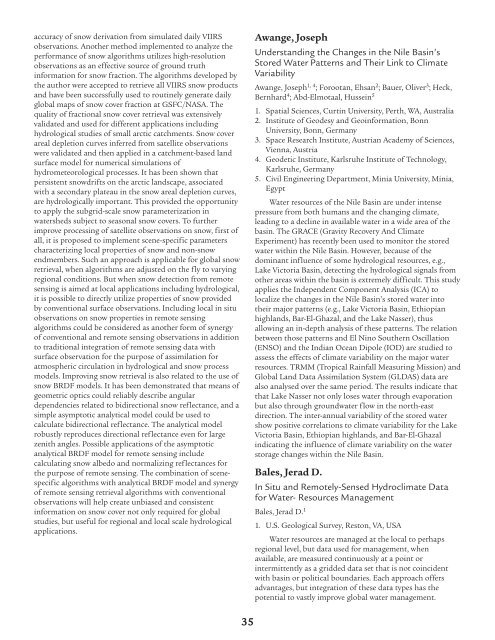2012 AGU Chapman Conference on Remote Sensing of the ...
2012 AGU Chapman Conference on Remote Sensing of the ...
2012 AGU Chapman Conference on Remote Sensing of the ...
- No tags were found...
You also want an ePaper? Increase the reach of your titles
YUMPU automatically turns print PDFs into web optimized ePapers that Google loves.
accuracy <strong>of</strong> snow derivati<strong>on</strong> from simulated daily VIIRSobservati<strong>on</strong>s. Ano<strong>the</strong>r method implemented to analyze <strong>the</strong>performance <strong>of</strong> snow algorithms utilizes high-resoluti<strong>on</strong>observati<strong>on</strong>s as an effective source <strong>of</strong> ground truthinformati<strong>on</strong> for snow fracti<strong>on</strong>. The algorithms developed by<strong>the</strong> author were accepted to retrieve all VIIRS snow productsand have been successfully used to routinely generate dailyglobal maps <strong>of</strong> snow cover fracti<strong>on</strong> at GSFC/NASA. Thequality <strong>of</strong> fracti<strong>on</strong>al snow cover retrieval was extensivelyvalidated and used for different applicati<strong>on</strong>s includinghydrological studies <strong>of</strong> small arctic catchments. Snow coverareal depleti<strong>on</strong> curves inferred from satellite observati<strong>on</strong>swere validated and <strong>the</strong>n applied in a catchment-based landsurface model for numerical simulati<strong>on</strong>s <strong>of</strong>hydrometeorological processes. It has been shown thatpersistent snowdrifts <strong>on</strong> <strong>the</strong> arctic landscape, associatedwith a sec<strong>on</strong>dary plateau in <strong>the</strong> snow areal depleti<strong>on</strong> curves,are hydrologically important. This provided <strong>the</strong> opportunityto apply <strong>the</strong> subgrid-scale snow parameterizati<strong>on</strong> inwatersheds subject to seas<strong>on</strong>al snow covers. To fur<strong>the</strong>rimprove processing <strong>of</strong> satellite observati<strong>on</strong>s <strong>on</strong> snow, first <strong>of</strong>all, it is proposed to implement scene-specific parameterscharacterizing local properties <strong>of</strong> snow and n<strong>on</strong>-snowendmembers. Such an approach is applicable for global snowretrieval, when algorithms are adjusted <strong>on</strong> <strong>the</strong> fly to varyingregi<strong>on</strong>al c<strong>on</strong>diti<strong>on</strong>s. But when snow detecti<strong>on</strong> from remotesensing is aimed at local applicati<strong>on</strong>s including hydrological,it is possible to directly utilize properties <strong>of</strong> snow providedby c<strong>on</strong>venti<strong>on</strong>al surface observati<strong>on</strong>s. Including local in situobservati<strong>on</strong>s <strong>on</strong> snow properties in remote sensingalgorithms could be c<strong>on</strong>sidered as ano<strong>the</strong>r form <strong>of</strong> synergy<strong>of</strong> c<strong>on</strong>venti<strong>on</strong>al and remote sensing observati<strong>on</strong>s in additi<strong>on</strong>to traditi<strong>on</strong>al integrati<strong>on</strong> <strong>of</strong> remote sensing data withsurface observati<strong>on</strong> for <strong>the</strong> purpose <strong>of</strong> assimilati<strong>on</strong> foratmospheric circulati<strong>on</strong> in hydrological and snow processmodels. Improving snow retrieval is also related to <strong>the</strong> use <strong>of</strong>snow BRDF models. It has been dem<strong>on</strong>strated that means <strong>of</strong>geometric optics could reliably describe angulardependencies related to bidirecti<strong>on</strong>al snow reflectance, and asimple asymptotic analytical model could be used tocalculate bidirecti<strong>on</strong>al reflectance. The analytical modelrobustly reproduces directi<strong>on</strong>al reflectance even for largezenith angles. Possible applicati<strong>on</strong>s <strong>of</strong> <strong>the</strong> asymptoticanalytical BRDF model for remote sensing includecalculating snow albedo and normalizing reflectances for<strong>the</strong> purpose <strong>of</strong> remote sensing. The combinati<strong>on</strong> <strong>of</strong> scenespecificalgorithms with analytical BRDF model and synergy<strong>of</strong> remote sensing retrieval algorithms with c<strong>on</strong>venti<strong>on</strong>alobservati<strong>on</strong>s will help create unbiased and c<strong>on</strong>sistentinformati<strong>on</strong> <strong>on</strong> snow cover not <strong>on</strong>ly required for globalstudies, but useful for regi<strong>on</strong>al and local scale hydrologicalapplicati<strong>on</strong>s.Awange, JosephUnderstanding <strong>the</strong> Changes in <strong>the</strong> Nile Basin’sStored Water Patterns and Their Link to ClimateVariabilityAwange, Joseph 1, 4 ; Forootan, Ehsan 2 ; Bauer, Oliver 3 ; Heck,Bernhard 4 ; Abd-Elmotaal, Hussein 51. Spatial Sciences, Curtin University, Perth, WA, Australia2. Institute <strong>of</strong> Geodesy and Geoinformati<strong>on</strong>, B<strong>on</strong>nUniversity, B<strong>on</strong>n, Germany3. Space Research Institute, Austrian Academy <strong>of</strong> Sciences,Vienna, Austria4. Geodetic Institute, Karlsruhe Institute <strong>of</strong> Technology,Karlsruhe, Germany5. Civil Engineering Department, Minia University, Minia,EgyptWater resources <strong>of</strong> <strong>the</strong> Nile Basin are under intensepressure from both humans and <strong>the</strong> changing climate,leading to a decline in available water in a wide area <strong>of</strong> <strong>the</strong>basin. The GRACE (Gravity Recovery And ClimateExperiment) has recently been used to m<strong>on</strong>itor <strong>the</strong> storedwater within <strong>the</strong> Nile Basin. However, because <strong>of</strong> <strong>the</strong>dominant influence <strong>of</strong> some hydrological resources, e.g.,Lake Victoria Basin, detecting <strong>the</strong> hydrological signals fromo<strong>the</strong>r areas within <strong>the</strong> basin is extremely difficult. This studyapplies <strong>the</strong> Independent Comp<strong>on</strong>ent Analysis (ICA) tolocalize <strong>the</strong> changes in <strong>the</strong> Nile Basin’s stored water into<strong>the</strong>ir major patterns (e.g., Lake Victoria Basin, Ethiopianhighlands, Bar-El-Ghazal, and <strong>the</strong> Lake Nasser), thusallowing an in-depth analysis <strong>of</strong> <strong>the</strong>se patterns. The relati<strong>on</strong>between those patterns and El Nino Sou<strong>the</strong>rn Oscillati<strong>on</strong>(ENSO) and <strong>the</strong> Indian Ocean Dipole (IOD) are studied toassess <strong>the</strong> effects <strong>of</strong> climate variability <strong>on</strong> <strong>the</strong> major waterresources. TRMM (Tropical Rainfall Measuring Missi<strong>on</strong>) andGlobal Land Data Assimilati<strong>on</strong> System (GLDAS) data arealso analysed over <strong>the</strong> same period. The results indicate thatthat Lake Nasser not <strong>on</strong>ly loses water through evaporati<strong>on</strong>but also through groundwater flow in <strong>the</strong> north-eastdirecti<strong>on</strong>. The inter-annual variability <strong>of</strong> <strong>the</strong> stored watershow positive correlati<strong>on</strong>s to climate variability for <strong>the</strong> LakeVictoria Basin, Ethiopian highlands, and Bar-El-Ghazalindicating <strong>the</strong> influence <strong>of</strong> climate variability <strong>on</strong> <strong>the</strong> waterstorage changes within <strong>the</strong> Nile Basin.Bales, Jerad D.In Situ and <strong>Remote</strong>ly-Sensed Hydroclimate Datafor Water- Resources ManagementBales, Jerad D. 11. U.S. Geological Survey, Rest<strong>on</strong>, VA, USAWater resources are managed at <strong>the</strong> local to perhapsregi<strong>on</strong>al level, but data used for management, whenavailable, are measured c<strong>on</strong>tinuously at a point orintermittently as a gridded data set that is not coincidentwith basin or political boundaries. Each approach <strong>of</strong>fersadvantages, but integrati<strong>on</strong> <strong>of</strong> <strong>the</strong>se data types has <strong>the</strong>potential to vastly improve global water management.35












